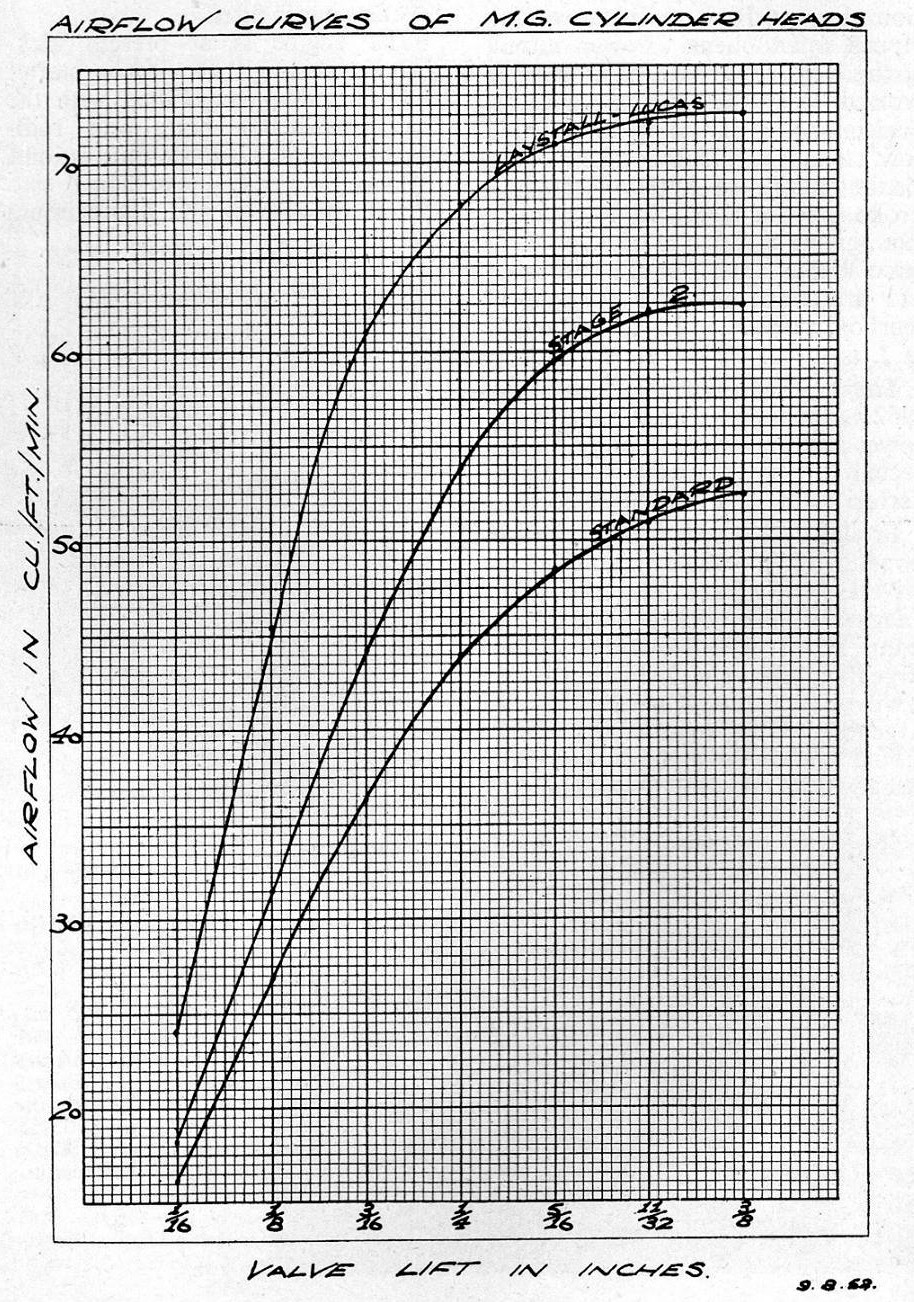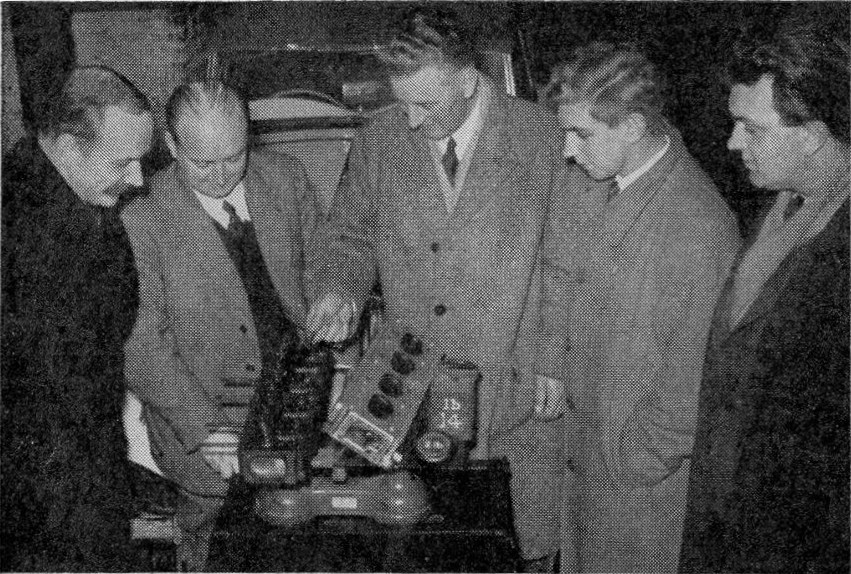An article about the Laystall-Lucas head from the December 26th issue of Autosport.
© Autosport December 26, 1952
Provided by Chris Taylor|
THE LAYSTALL-LUCAS CYLINDER HEAD A High-Performance Light Alloy Head for M.G.s |
||||
|
POWER-UNIT of the world's most popular sports car, the 1250 c.c. M.G. engine, is a rather remarkable acheivement. In standard trim, with a 7.25 to 1 compression ratio, it performs well on almost any fuel. Modified to take extra-large valves, and with a higher ratio, it can, and does, appear with distinction in speed events. The manufacturers actually approve of such tuning, and supply parts and instructions for the purpose. Now, the Laystall Engineering Co., Ltd., have made available a special head, designed ab inito in high-compression form. It in-corporates the larger valves and stronger springs normally supplied |
the extra urge, and some slip took place at the getaway and on chang- ing gear. Stronger clutch springs are readibly available, and would be well worth having. The actual changing of the heads was done inside an hour and half, or 1¾ hours if one includes warming up and checking valve clearances. In order to accommodate the specially shaped ports, the Laystall- Lucas head is somewhat wider than the standard article. The regular manifolds and gaskets go straight on, however, and any normally com- petent owner could do the work himself. The M.G. engine is very |
accessible, so the job is quite straightforward. I also used the M.G. as my normal hack for a few days, and the improvement in performance was most marked. Although the maxi- mum speed is considerably aug- mented, it is the better acceleration in the middle ranges that one notices most in everyday driving. I used 80 octane fuel, on which the unit was remarkably flexible. I am told that the high commpression-ratio does not preclude the use of pool petrol, but as branded spirit will soon be available everywhere, I did not bother to verify this. |
||
|
for ”Stage II” tune, and these are included in the price of £48. It is cast in RR 50 aluminium alloy, which not only eases all the heat- flow problems, but saves 16 lbs. of weight. The main feature, however, is the scientific proportioning of the ports and head shape, which greatly increases the air flow, as the accom‐ panying graphs show. The technical side of the project is the work of John Lucas, who has put the speed into many of our fastest engines. On the bench a b.h.p. increase of some 20 per cent is recorded, by simply changing cylinder heads, and making no other alterations to the engine. Bench tests are all very well, but it is road behaviour that really counts. Accordingly, I took over a TD type M.G. recently, to see if the theoretical advantages were obtained in practice. It will be observed that, in the data panel, performance figures are given for the car in standard form and with the Laystall-Lucas head fitted. These results were secured at the M.I.R.A. proving ground, and were electrically timed. It will be realized that the length of run avail- able did not allow the ultimate maximum speed to be developed, but the figures are strictly compar- able. Having tried both heads with the standard 1¼-in. S.U. carburetters, the new head was finally fitted with 1½-in. instruments. Although the engine felt considerably livelier at the top end of the revolution range, the times recorded were not enor- mously better. This was simply be- cause the clutch disliked handling |
 |
|||
 |
COMPARISON: John Bolster, Basil de Mattos (Laystall's), John Lucas, Martin Burgess (W.H.M. Burgess, Ltd.), and Ronald Goldberg compare the standard M.G. TD cylinder head on the scales with the light alloy Laystall-Lucas unit. to welcome this new compenent with open arms. Where the cylinders have been over-bored to contain a piston-swept volume approaching 1½ litres, the head will give a compression ratio around 10½ to 1. Still higher figures are possible if domed pistons are employed, and 1½-in. carburetters would certainly be desireable for such work. The weight-saving conferred by the light- alloy head will be appreciated by competition drivers. Pause, then, you sports-car |
|||
|
During my test, freezing tempera- tures were experienced most of the time, and I did not even cover the bonnet with a rug at night. Never- theless, starting was rapid and cer- |
is ”ready tuned“, so to speak, and no work is entailed apart from fitting. On the other hand, the gentry who race M.G. engineered cars are sure |
owners, before you cross swords with an innocent-looking M.G. It may have a Laystall-Lucas cylinder head under its bonnet, and you will be in for a rude awakening! JOHN V. BOLSTER. |
||
|
tain every morning. The fuel con- sumption worked out at 28 m.p.g., but as this included the flat-out |
SPECIFICATION AND PERFORMANCE DATA | |||
|
timed runs, I would say that a full 30 m.p.g. could be relied upon for ordinary journeys. This head is applicable to the TB, TC, TD and 1 ¼-litre saloon model M.G.s, also the new Wolseley 4/44 though twin carburetters and mani- folds must, of course, be obtained for the two latter cars. It repre- sents a remarkably cheap way of augmenting the performance, for it |
Component Tested: Laystall-Lucas Cylinder Head, tested on TD type M.G. car. Price U.K. £48, or £50 including fitting. Material: RR 50 aluminium alloy, with valve inserts. Valves: 36 mm. inlet, and 34 mm. exhaust valves, with 150 lb. springs. Rocker Gear: Standard rockers and all other fitments. Compression Ratio: 9.3 to 1. Performance: 20 per cent. power increase. |
Test Results: Standing figures are for
last 100 ft. of ¼ mile. Flying figures
are for last 100 ft. of 1,400 yds. |
||
Home | History | Details | Myths and FAQs | Literature | Entertainment | Gallery | Links | Map
| © 1999 - by Christopher C. Couper | Page last modified: 2025/06/26 |